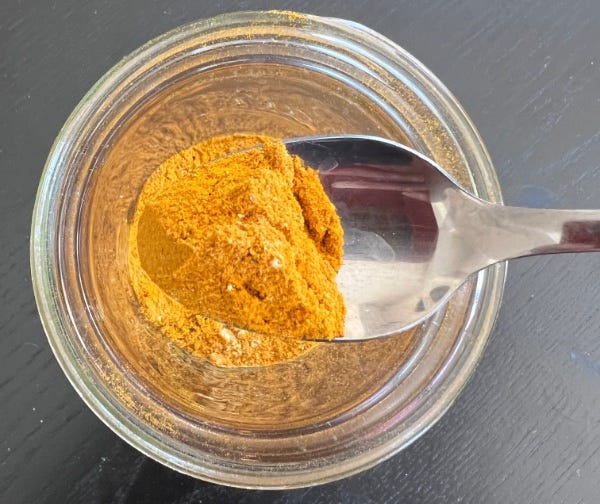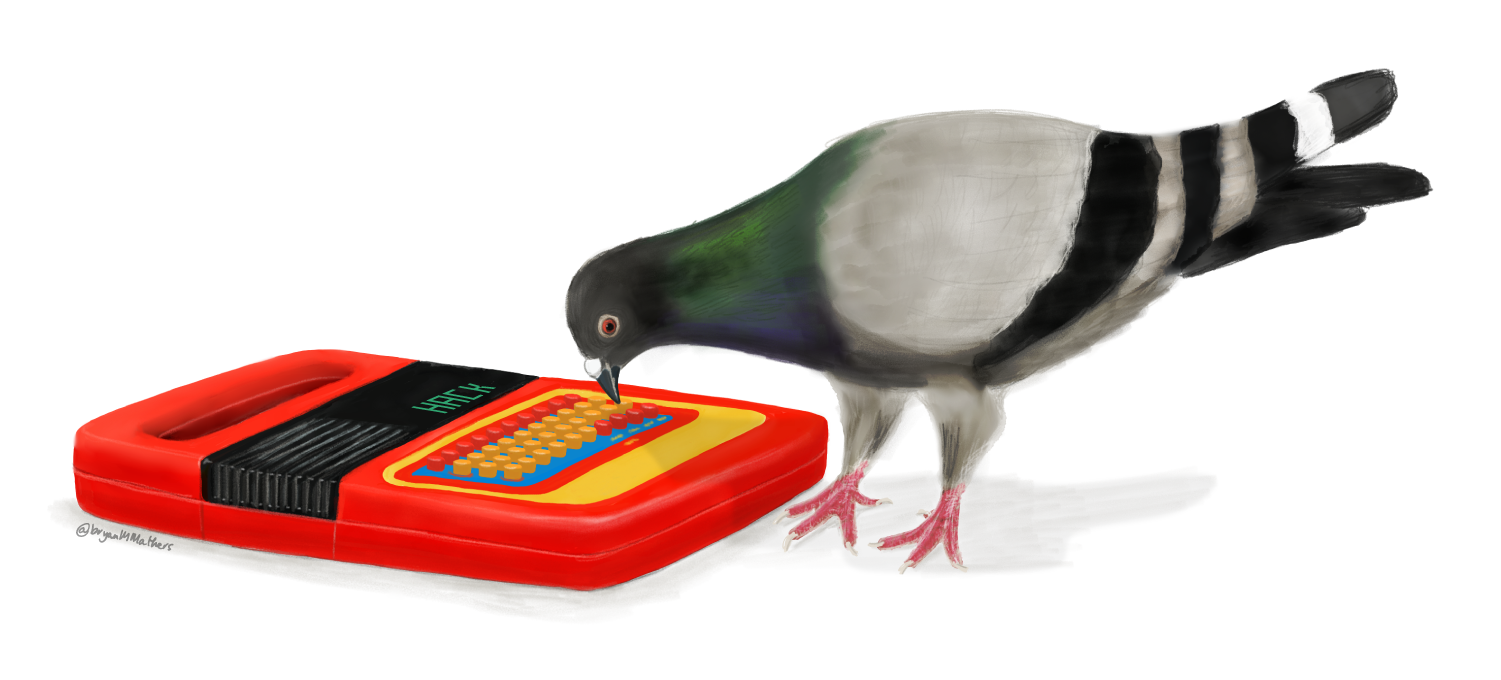What's For Breakfast?
Golden Milk Powder (and some thoughts on the problem of "healthy recipes")
Every Monday, I'll send subscribers — only paid subscribers eventually — a recipe for a breakfast item. There'll be themes each month: June's will be muffins; July's will be oats — you get the idea. I'll write a little bit about the history of the item — how'd we end up with oats sold in a round cardboard cylinder with a Quaker on the front of it, for example. I'll write too about the culinary practices of breakfast — what's the difference between a cupcake and a muffin? Who says one is appropriate for eating before 11am and the other, a sign of moral weakness?
As this is the soft launch of Second Breakfast, consider this issue of the newsletter my first stab at writing and publishing a recipe.
I know a lot of folks whine about the ways in which the web has distorted this very thing. You have to scroll through so many words and images on a website before you get to the actual recipe itself. For the record, you can't really blame the food bloggers for this. The overblown introductions are the result of Google Search, which requires publications do all sorts of things in order for content to be prioritized in the Search algorithm, hell, to even be found at all. A website has to be constantly updated, for example, and a recipe has to be accompanied with narrative and photos, not just a list of ingredients and instructions on how to assemble them. (I recently discovered while searching for an old story I wrote to link here that the now-defunct Hack Education no longer reliably shows up in searches for ed-tech topics, even with a very specific "hack education" search string.)
Most recipe websites do let you click on a "jump to recipe" button so you can skip over the verbiage of how the writer's grandmother used to make biscuits by scratch or keep raisins in a glass jar next to the honey or how the smell of applesauce simmering on the stove reminds the writer of the scented candles in her piano teacher's bathroom. I haven't figured out yet how to add that navigational short-cut to this newsletter — soft launch, remember? — and I don't have the excuse of "Google made me do it" when I include a long-winded introduction, like this one, to my recipes.
I would ask that you simply consider this recipe a practice attempt at food photography — I bought a special camera stand to hold my iPhone and light my kitchen table, but the package hasn’t shown up yet. Perhaps consider it a practice attempt at recipe formatting. Consider it a practice attempt at writing a set of instructions that can be readily followed by someone else. (This is hard!) Consider it a practice attempt at that very annoying intro-to-recipe narrative — how much do I want to say about my experiences with Golden Milk Powder? And more importantly, how much do I want to say about this recipe its purported "health" benefits?
That last one is easy: not much. Recipe blogs will often put "healthy" in the title and description of almost anything: "healthy muffins," "healthy biscuits and gravy," "healthy baked oatmeal, "healthy granola," "healthy grits," "healthy breakfast burrito," and so on. Some of these recipes do promise less sugar; some less fat or no gluten or no meat or more fiber, and so on — whatever might signal “healthy.” Some of these recipes are, let’s be honest, simply responses to that well-oiled SEO machine, knowing that plenty of people are indeed looking for ideas of something to cook that’s "healthy.” It’s not always clear what exactly that adjective means, if it means anything at all. Some recipes might swap ingredients in ways that seem “healthy”: coconut sugar or maple syrup instead of granulated sugar, for instance, or olive oil instead of butter — but good grief, I really don’t want to get caught up in this nutritional fine-tuning and fixation. Some recipes will make health-based claims about certain ingredients: "the 10 benefits of golden milk powder and how to make it" sort of thing.
We want to start our day out right, but for lots of us, for lots of reasons, that is really really really hard. And there are often structural reasons for this. “Health” is never simply about the individual choices we might make about what beverage to drink in the morning.
For what it’s worth, there is research that shows that turmeric, the key ingredient in golden milk powder, may help with inflammation, muscle soreness after exercise, and anxiety. Cinnamon, another ingredient in the mix, may lower cholesterol — all reasons why I am more than happy to make golden milk powder, keep it next to the tea bags in the kitchen cupboard, and turn it into a hot beverage almost every afternoon. (Plus, and this is key: I think it's delicious.)
But there are limitations to the research on the active ingredients in these and all manner of spices, and while plenty of pharmaceutical websites are going to urge you to consider taking them as a supplement and plenty of recipe blogs will suggest your cooking with them can help treat your maladies, I am really wary of any of this kind of thing — not just for legal reasons (I am not a doctor, not a dietician, etc etc), but because I think that that all the pronouncements and judgments around "healthy food" get really messy really fast.
Indeed, we often find ourselves in the trap of "healthism," where what we cook and what we eat, particularly for breakfast, are tied up in moralism and pseudoscience.
That's in part why I'm writing this newsletter, so we can untangle some of these stories and try to find some pleasure and strength and justice in our mornings. If you like to cook — and I like to cook — and if you like to eat — my god, I love to eat — Second Breakfast has some thoughts about what’s on the menu in the morning and why.
ANYWAY. Here is my recipe for golden milk powder:
Golden Milk Powder
Makes about 20 servings
4 Tbsp turmeric
2 tsp ginger (plus more to taste)
2 tsp cinnamon (plus more to taste)
1 tsp ground black pepper (plus more to taste)
1/8 tsp ground nutmeg (plus more to taste)
1/8 tsp ground clove (plus more to taste)
1/8 tsp cayenne, optional (or more to taste)
To make mix, add all the spices to a small jar and shake or stir thoroughly to combine. This will keep at room temperature up to 3 months, but if, like me, you use it daily, you'll probably be making a batch every couple of weeks.
To make a drink, add 1 heaped tsp of the golden milk powder and 1-2 tsp sweetener (optional) to a mug that you don't mind being stained yellow. Add boiling water from the kettle and a splash of milk (dairy or non-dairy — you choose). Or, for a milkier drink, add the milk powder and sweetener to a saucepan, along with two tsp of water. Stir til combined, then add a cup of milk of your choice and whisk, heating over medium heat until hot — but not boiling. Drink as is or — and this seems to be pretty popular these days — you use take this golden milk in your coffee.
This recipe also works as a spice mix to add to vegetables, sauces, smoothies, and muffins — look for a recipe for the latter in June.

Yours in struggle,
~Audrey





